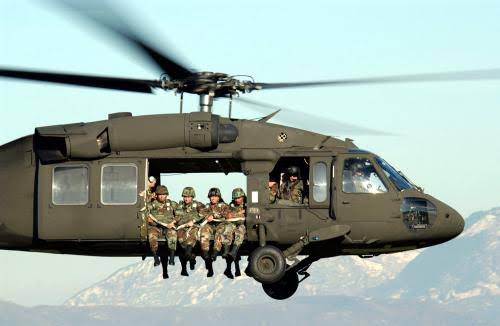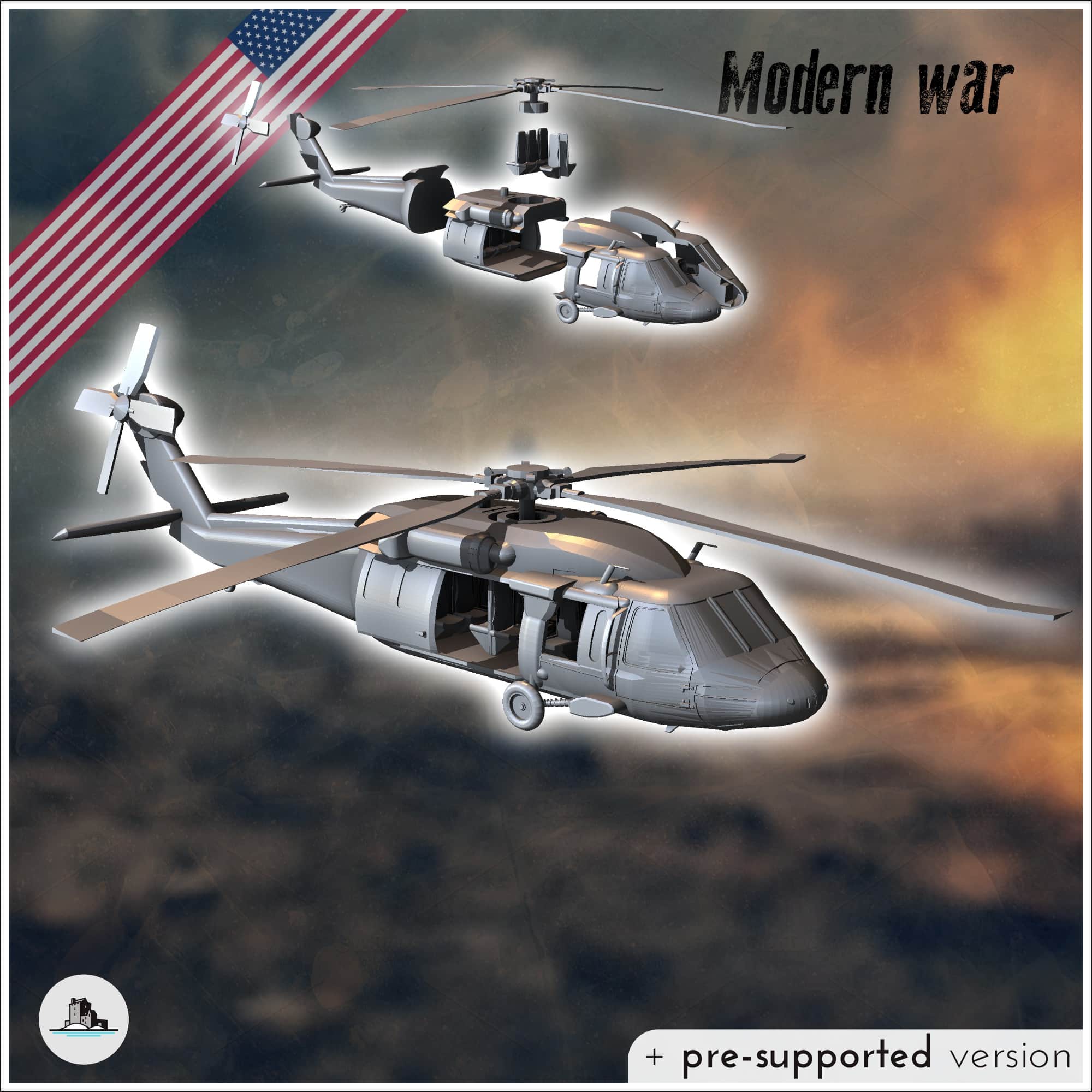Comprehending the UH60: The Ultimate Military Helicopter Experience
The UH-60 Black Hawk helicopter stands for an essential development in military air travel, combining durable engineering with diverse operational abilities. As we explore the background, specifications, and technical advancements of the UH-60, it comes to be evident that its function in shaping contemporary military methods is both considerable and far-ranging.
History of the UH-60
Arising from the need for a flexible energy helicopter throughout the late 1960s, the UH-60 Black Hawk was developed by Sikorsky Aircraft Company in response to the U.S. Army's need for a modern field of battle transport helicopter. The style procedure started in 1972, culminating in its very first trip in October 1974. The Black Hawk was crafted to replace the aging UH-1 Iroquois, likewise called the "Huey," which had actually been a staple of Army air travel given that the Vietnam Battle.

Over the years, the Black Hawk has undergone numerous upgrades, maintaining its relevance in modern military operations. Its success has actually brought about the growth of numerous variations, serving multiple branches of the U. UH60.S. military and allied forces worldwide, developing the UH-60 as a keystone of armed forces aeronautics history
Key Features and Specs
The UH-60 Black Hawk is differentiated by its advanced design and durable specs, which add to its flexibility on the battleground. This multi-role helicopter features a twin-engine arrangement, powered by 2 General Electric T700-GE-701C engines, providing a maximum result of 1,800 shaft horse power each. This powerful engine setup permits the Black Hawk to reach an optimum rate of roughly 183 knots (211 mph) and a service ceiling of 19,000 feet.
The airplane's composite rotor blades supply phenomenal lift and ability to move, while its four-blade major blades system improves stability (UH60). The Black Hawk is geared up with advanced avionics, including an electronic cabin and night vision capabilities, ensuring reliable procedures in varied conditions. Its cabin can suit as much as 11 troops or bring as much as 8,000 extra pounds of cargo, making it ideal for different logistical needs
The UH-60's modular style enables very easy maintenance and upgrades, making certain durability and adaptability in evolving army demands. In addition, its sophisticated survivability attributes, such as crashworthy seats and armor, improve staff security throughout missions. In general, the UH-60 Black Hawk stands for a considerable innovation in military air travel modern technology.
Operational Functions and Goals
Flexibility is a characteristic of the UH-60 Black Hawk, allowing it to carry out a vast array of functional duties and missions throughout different army environments. Largely designed for troop transport, the Black Hawk can bring approximately 11 soldiers and is regularly utilized in air assault procedures, permitting rapid insertion and extraction of ground forces in click resources opposed locations.

In enhancement to army transportation, the UH-60 is adept at clinical discharge (MEDEVAC) goals. Equipped with advanced clinical tools and employees, it can promptly leave damaged soldiers from the battlefield, considerably improving survival prices in essential situations. The helicopter likewise plays a vital duty in logistics support, delivering supplies, ammunition, and devices to ahead operating bases in ascetic environments.
Additionally, the Black Hawk serves as a system for unique procedures missions, including reconnaissance and direct activity. Its ability to operate in different terrains and its low-flying abilities make it a necessary asset for devices carrying out hidden operations.

Technological Innovations
Technology in air travel technology has actually considerably enhanced the abilities of the UH-60 Black Hawk, ensuring its significance in modern armed forces visite site operations. The helicopter is furnished with advanced avionics systems that supply pilots with exceptional situational recognition, including multi-functional display screens, enhanced GPS, and sophisticated terrain recognition systems. These functions enable exact navigation and mission implementation, also in difficult environments.
Furthermore, the integration of data systems enables instant and safe and secure information exchange between devices, facilitating collaborated procedures. The UH-60's updated blades systems and composite materials contribute to enhanced efficiency, offering higher rate, dexterity, and reduced maintenance costs.
Furthermore, innovations in tool systems, such as the ability to deploy precision-guided munitions, boost the Black Hawk's duty in fight scenarios. The helicopter's capacity to support medical emptying goals is additionally bolstered by new medical equipment and innovations, making certain efficient patient care en route.
Finally, continuous enhancements in stealth innovation and sound decrease systems better solidify the UH-60's effectiveness in covert procedures, permitting it to run in aggressive areas with a lowered chance of discovery. Jointly, these technological developments underscore the Black Hawk's enduring prominence in army aeronautics.
Effect On Modern War
Improved capabilities of the UH-60 Black Hawk have actually exceptionally influenced modern-day war techniques and tactics. Its versatility in army transport, medevac operations, and reconnaissance roles has redefined the operational landscape for military forces. The helicopter's ability to operate in varied atmospheres, from metropolitan setups to rugged terrains, permits better tactical adaptability, making it possible for commanders to adjust quickly to changing combat zone conditions.
The UH-60's innovative avionics and communication systems boost situational awareness, promoting real-time intelligence sharing and control among devices. This capability is critical in contemporary crooked warfare, where quick decision-making can figure out the outcome of interactions. The helicopter's capability for fast insertion and extraction of special procedures forces top article has come to be a hallmark of contemporary military campaigns, stressing rate and accuracy.
Furthermore, the Black Hawk's combination with unmanned airborne systems and various other advanced technologies symbolizes a change in the direction of multi-domain procedures. As a result, the UH-60 not only works as a crucial property in standard problems but also plays a critical function in counterinsurgency and peacekeeping objectives, emphasizing its long-lasting influence on modern-day military teaching and the evolution of warfare.
Conclusion
The UH-60 Black Hawk stands for a peak of armed forces aviation, characterized by its convenience, progressed engineering, and durable style. Constant technical improvements and enhancements have further strengthened the Black Hawk's critical importance, enabling quick feedback and versatility in diverse fight situations.

Innovation in air travel modern technology has actually considerably boosted the capabilities of the UH-60 Black Hawk, ensuring its significance in modern-day military operations.The UH-60 Black Hawk represents a peak of armed forces aeronautics, characterized by its convenience, progressed design, and robust layout.